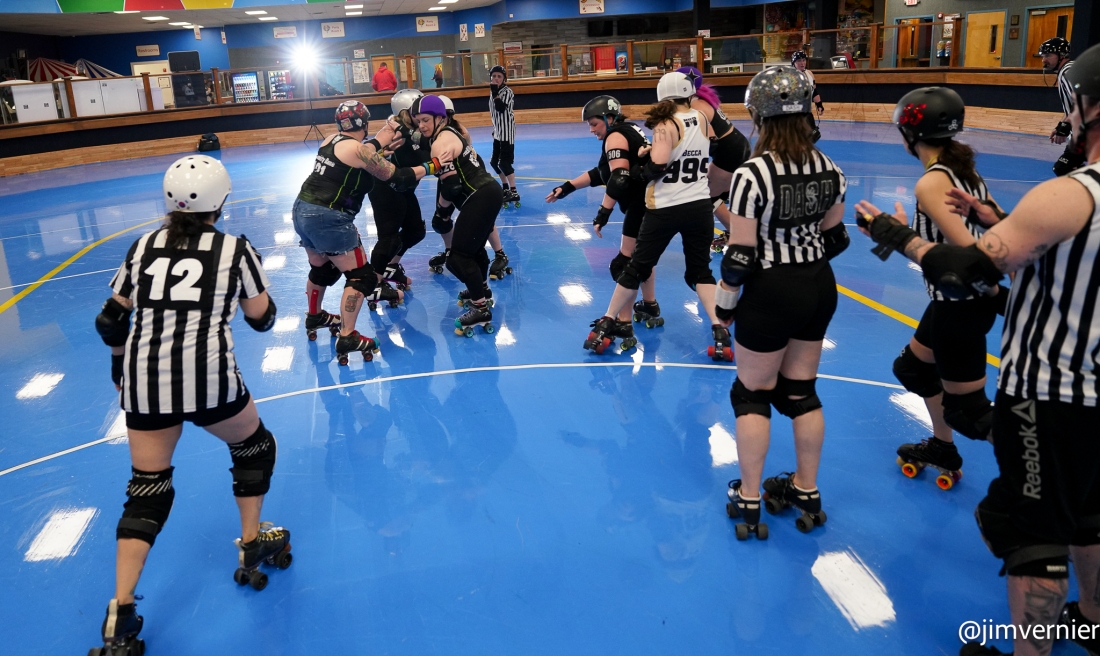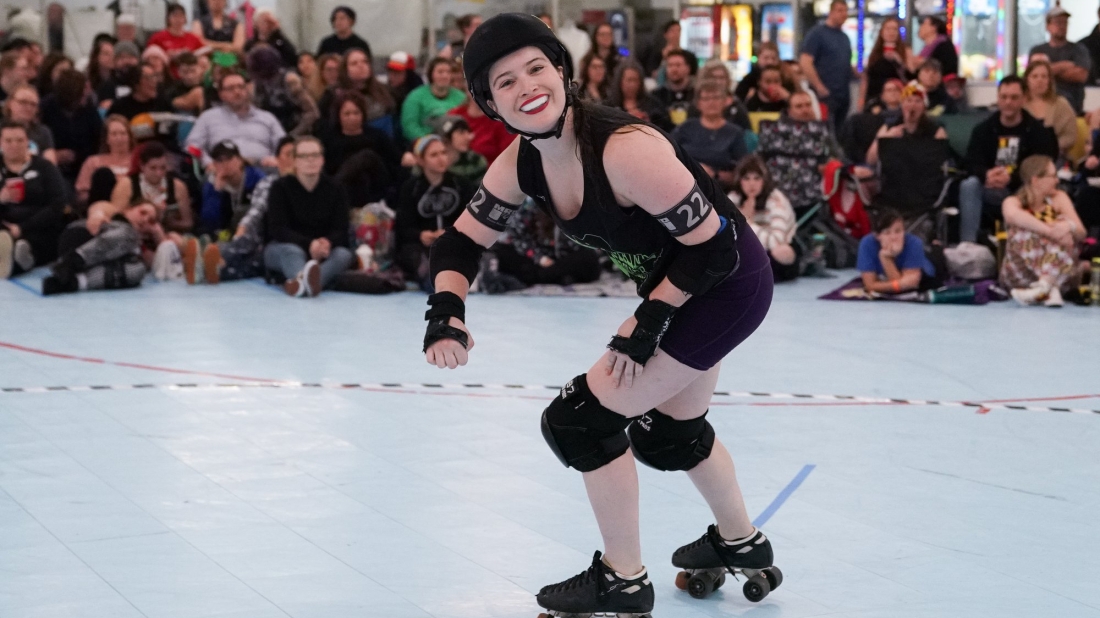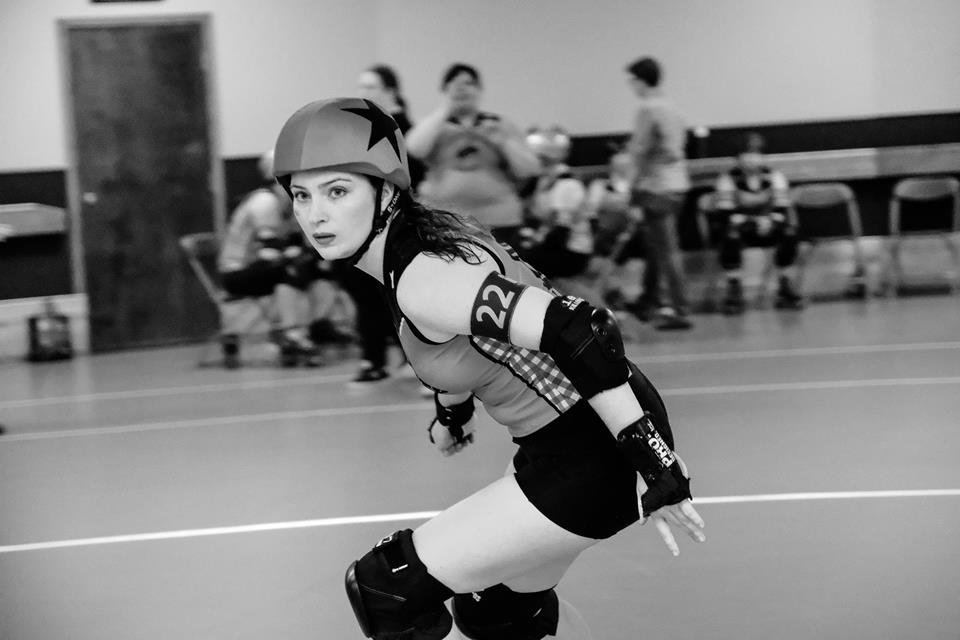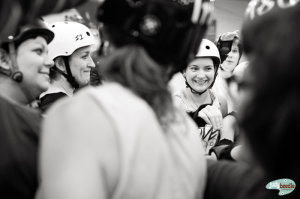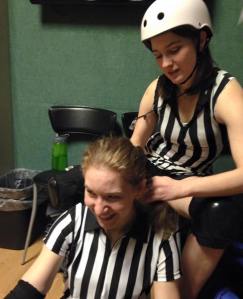No one tells you how to be a head referee, or what’s involved.
In publicly available WFTDA documents there’s not a lot of information, aside from “The Head Referee is the ultimate authority of the game” and some notes on expulsions, communication with skaters, official reviews, and forfeits. I’ve been a skater for 13 years now, and a referee for 11.
As a skater-official, I’ve not sought cert and I don’t seek to travel for higher-level regional/national officiating roles. My WFTDA team eats up enough of my life 😅. However, I love officiating for my league’s home teams, our B roster, and my local MRDA league. I think a lot of us are in this, “this is a casual hobby, but I want to be better” cohort. Certainly our cohort outnumbers the Level 2+ certified officials [however, serious officials, please weigh in in the comments if I misspeak, or if there are resources we should all know about, even us plebs. I’ll edit to add them in here].
Maybe none of us actually know what a Head Ref’s role is? So, if you will, I — a fellow pleb — would like to tell you what’s been working for me. This Head Reffing 101 guide includes a lot of examples to help make the ideas concrete in practice:
If you’ve never offered to HR, but you’re a pretty good ref: Try it
Step one is to step up. You will feel unqualified. You are unqualified. This is how you become qualified. If you know the rules, can skate, can be professional and kind, and care about your officiating teammates, you’re probably ready.
Know what’s most important
Taking care of your officiating teammates is your priority. During the game, it’s to ensure the bout is: Safe, fair, efficient. The vibes you bring into this game will be reflected back to you by your crew — be a calm, respectful leader.
Taking care of your officiating crew can look like this:
- Know their names and positions [skating officials and off-skates officials]
- Treat them like the incredible volunteers they are; and establish a culture of teamwork and camaraderie
- Prioritize their needs over the needs of the teams — this is the “put your own mask on first” situation; if your crew feels safe and empowered, that will help ensure safety and fairness for the skater-teams. Of course, if a skater is lying on the floor bleeding but your JR needs information about points … you’ll prioritize the skater; but if other things are equal, your team comes first.
- Collaborate with each other and with off-skates officials
- Delegate [I’ll hit on this below]
- Anticipate their needs, to the best of your ability
- Celebrate successes, professionally1
Conducting a safe, fair, efficient game
But how do you keep the game safe, fair and efficient? This isn’t an exhaustive list, but here’s a start:
Safe: Nip shenanigans in the bud. Are skaters [verb]ing dangerously, but not enough to warrant a penalty/expulsion? Warn them. Warnings are a great tool. If it’s a specific skater, warn them specifically — you’re allowed to communicate with them. This is often more impactful than, “hey I’m telling both teams this: Don’t baseball slide into the penalty box at 70 mph, please!” — just tell the person, “White, 22, I’m issuing you a warning. Please enter the box safely; we need to ensure all NSOs feel safe and respected.”
However, if it’s heated, it can be helpful to leverage their coach, who knows the skater best.
Example language: “Hey Coach, I’m noticing some disrespectful language/behavior from White 22. It needs to stop. This is a warning. We cannot tolerate this; let’s keep the game fun and fair for everyone.”
Fair: If you feel members of your officiating crew are seeing things with slant toward a team … well, first of all this can be normal. The common example of this is when Ref A comes from Team A where they officiate weekly. They’re used to Team A’s moves, habits, gameplay. They may not have as keen of an eye for their home team as you do. Take a gentle approach and offer that feedback to your whole crew.
Example language: “I’m seeing occurrences of light pushing on blockers’ backs that’s having an impact, because the jammer is pushing the skater passed opponents; let’s call those back blocks as we see them. As a reminder, the blocker doesn’t need to go down or out of bounds for that to have impact.”
For fairness from the skating-side, remember that “unsporting conduct” is a penalty2, and a warning you can issue.
Deescalation: This is a part of both “safe” and “fair.” To do this well takes a lot of development as an HR, but you have a few tools. Warnings are one. Time stoppages (official time outs) are another, but use them sparingly. Phrases like, “same team, same team” can help skaters understand when something seemingly illegal happens, if it’s their own teammate causing it. A gentle, neutral shake of the head can help a lot of situations.
Example: Skater thinks they’re lead jammer and can call it off; or a blocker thinks the other jammer cut them — a gentle and friendly headshake can quickly communicate to skater, “I saw what you’re thinking and it’s a no.”
Efficient: The easiest thing for you to control is official time stoppages (barring injury). Conducting efficient official reviews is a skill you must master. You also must set expectations for your crew, if they’re invited into the Official Review (OR) discussions. Set a goal for yourself to keep all Official Time Outs (OTO) under 3 minutes, and ORs under 4 — it’s not always possible, but it’s a good goal to start with.
Example: Before the game starts, in my crew meeting, I tell officials: “You’re welcome to listen to the ORs. But when we go talk about it, please only speak up if you saw the action.” That might seem obvious, but without that expectation setting, sometimes you waste an entire minute with, “I didn’t see that; I was [long explanation]”s.
Remember your NSOs: Invite them in if the OR involves their work. Also: Who will communicate the result of the OR to the box, the scoreboard, the PTLT, the jam timer, the in-house announcer? Delegating, in collaboration with your HNSO, will ensure the time stoppages don’t take an extra three minutes of only-you skating around with the info.
Tips on coaching refs
Like goalies, officials aren’t used to praise. You gotta praise them. “That was a great no-call,” is one of the best — and least-used — phrases in roller derby.
How are you going to help your OPRs and your alt ref grow? Will you have the mental bandwidth to pay any attention to your OPRs while you IPR? If not, you need to think on this. Tools you have may include: Other OPRs, NSOs, benched colleagues.
Example: If one of your OPRs is very experienced, upgrade them to OPR-Captain. Ask the OPR if they’re willing, then put them in the middle, then tell the other OPRs in your pre-game meeting, “Hey, [Name] is our OPR leader today, they’re going to help ensure we’re working well together and that you’re getting the feedback you need and deserve.” Empowering the outside is a great development opportunity, and it delegates some mental load off your plate. Some NSOs, alt refs, or not-rostered officials in the crowd may also be able to be half-time/after-game feedback coaches.
Delegate the mental load
You can hoard all the work for yourself, but why. You have six other capable humans on your direct crew. One thing I’ve found wildly helpful is doing this (with my HNSO’s permission):
- Ask jam timer to let you know if the people near the scoreboard need something (they look at the scoreboard a lot)
- Ask one OPR to keep an ear/eye on the penalty box during gameplay, to make sure they don’t need anything (like recalling a skater for leaving early); ask them to look at the box between jams to ensure the three NSOs are OK/don’t need anything
- Ask an OPR to ensure the right number of skaters are on the track
- Ask an OPR to watch all skaters as they leave the track every jam
- If you’re HR’ing from the front: Ask your back IPR to keep the pack together, but to toss it to you if the pack goes forward
- Ask your other IPR to tell the penalty box the result of any ORs3
- Ask a PTLT to ensure the right number of pivots are on the track
- Ask both PTLTs to let you know when skaters hit 5, 6 and 7 penalties
- Ask your alt ref to tell the scoreboard the result of any ORs
- Ask the announcer to come into the OR to hear it, and hear the result
A lot of leagues seem to have a culture that NSOs are one team and referees are another team … but if we all work together to ensure the game flows smoothly, it’s easier on everyone. It also is more fun because everyone knows you trust them with a special task, and that sense of responsibility often brings dignity and autonomy. By not gatekeeping typical “HR jobs” we build a real team that relies on each other, and can go further and do better than any one member.
Overturning bad calls
If there’s a call you’re considering overturning: Tread carefully.
Fixing a no-call is easier because you can either call it yourself, or fix it between jams. You can’t un-do a served penalty though.
If it’s a sanctioned game, and you clearly saw the whole action and the “bad call,” then you need to make the right call … even if it means overturning another ref’s. Often it can’t wait.
Example: Ref makes a bad cut call on jammer only a few seconds in the jam … the team can’t regain that :30 of points later, if you don’t immediately pull jammer out of the box.
But hopefully the first time you HR is not a sanctioned game. And often you’re most likely as a newer HR to see only most of what happened. If it’s a Monday-night scrimmage, or a charity scrimmage, you have the opportunity to choose your referee over making a perfect call. (I’m preparing for a lot of skater hate-mail about this … but have non-officiating skaters read this far? Probably not.)
Example: At a charity scrimmage you’re pretty sure you saw a sustained backblock that had impact. At the end of the jam, you approach JR and say, “Hey, at the beginning of that jam, that really looked like a sustained backblock to me. The impact was that your jammer gently pushed on White 22’s back until they were out of the pack, passing 3 other skaters while gently back-blocking.” And then let them think. The likely answers are going to be: defensive, agree, didn’t see. Here’s how to deal with each:
Defensive, and you aren’t certain of the call: If they say, “THAT DIDN’T HAPPEN” and you aren’t 100% sure of the call, you need to trust that they saw it and accurately called/no-called it.
Defensive and they’re wrong: If they’re defensive and you 100% know you saw things correctly, you need to
1) Listen to them explain exactly what they saw. This is important because you might learn different information, or you might learn that the ref needs coaching on the impact spectrum.
2) Explain what you saw, and why you believe it’s a penalty.
3) Make the call while preserving the ref’s dignity
Example: “I understand we see this differently. I’d love to talk more about this after the game, but this OTO has run a bit long already. I need you to go call the penalty on the skater, please.” If it’s a JR, it IMO preserves the ref’s dignity if they make the call on their jammer. If it’s a pack ref, you can communicate the call to the skater yourself. This disagreement can be confidential, unless you strongly feel other officials had eyes on the situation. How you treat officials will directly impact if people work with you/staff you/work with your team again.
They agree: They will go call the penalty.
Example: This often sounds like, “Oh, I thought I saw that but my brain didn’t process it quickly enough to call it, sorry. I’ll go call it.” If this is the case, be kind and let it go. We’re all trying our best.
They didn’t see it: If they didn’t see it, you can say, “I’m sure; would you mind calling the penalty?” or “I’m not 100% sure, so we can let the no-call stand, but it’s something we should keep our eyes out for.” Using “we” language is helpful to not place blame.
In these situations, it’s likely one of the teams might OR the situation. It all happens fast, but this is a great opportunity to prioritize your crew, and serve the skating teams fairly.
Example: If you are questioning a call, AND a captain calls an OR … make the skater-team wait. Call an OTO. Tell the captain, “I’ll be right with you, but I need to discuss something with my team first.” Have the discussion. If from your discussion with your team you made a new call, or changed something, go to the skater captains (who will be gathered together already) and say, “Hey, the officiating crew is making X call on Y skater. Team A, I know you were calling an OR. Would you still like to use the review?” They may say, “no, that’s what we were going to review, thank you!” If that’s the case, let them keep their OR; and tell the scoreboard that. Continue gameplay. (It would not be fair to hear the OR first. If you suspected there was an officiating error, it’s on you to fix it quickly.)
Your pre-game meeting
The officials meeting: Say less. This is so not a time to show how smart you are, and how many rules you know. It is the time to show your crew that they are a team that works together to throw a safe/fair game; and that each of them matter to you. You’ll need to tell everyone where the medics are, and any weirdsies about the venue.
The captains meeting: Set the tone you want. Tell them where medics are, and venue weirdsies.
Example language: “Hey folks. I’m [Name], your head ref tonight and this is [HNSO introduces self]. We’re going to have a fun game tonight. The medics are over there, by the scoreboard. This venue does not allow glass water bottles. Do you have any hard of hearing skaters, or anything else the crew should know?”
Also: Notice how far down the list this is? A newer HR can think that this meeting is incredibly important. It is, but it’s not as important as everything you do in the game and how you treat your folks. Use this meeting to set the tone … and think about what you want that tone to be. Do you want it to be a fun game where officials enjoy themselves? If so, that officials meeting doesn’t start with, “My definition of [penalty/impact spectrum] looks like this. Watch out for XYZ.” It might start with, “Folks, this is [Ref’s] 50th game today! It’s also [NSO’s] first time trying [role] so let’s all support them!”
One note that I can’t fit into any other category: Officials are their own team, but that doesn’t mean they aren’t against skater-teams. All three teams need to work together — ideally in a friendly, professional manner — to enable great roller derby.
As you grow; share the space
Encourage others to HR. Even if they’re a little unqualified4; you were too once. We need to support others as they want to step up. Having several people on a track who have HR experience is wildly helpful. In addition to the rules/gameplay knowledge, having experienced HRs also helps logistically. It means when a situation occurs (“we’re sending White 22 to the box as jammer in the last jam”) one person can communicate with the penalty box, while another talks to scoreboard, and another informs the teams.
Inevitably I missed stuff. Inevitably some of you disagree with me. Put it in the comments, but be nice. We’re all trying to make roller derby happen ❤
If you read all this way, but you’ve never actually referee’d before, read this other post I made years back: https://harddash.com/2018/08/23/how-to-learn-to-ref-a-derby-skaters-guide/
Featured photo courtesy of Jim Vernier, thanks Jim!
Footnotes:
- One time a fellow skater-official was so happy to finally call a penalty [it’s exciting!] that she called it so cheerfully it was a tad insulting to me, the skater. Do celebrate; do be professional. ↩︎
- WFTDA rule 4.3. “Penalties for Unsporting Conduct (Misconduct): All participants in a game of roller derby must be respectful of one another. This includes but is not limited to Skaters, Team Staff, Officials, mascots, event staff, and spectators. When Skaters or Team Staff behave in an unsporting manner, their misconduct should be penalized accordingly.” ↩︎
- Why does the penalty box need to know? They’re your TEAM. If you want everyone to feel included, you need to include everyone. ↩︎
- A little. Meaning they know the rules and can skate. Don’t just throw anyone at the HR job. But if you’re on the fence about it, and might just be being a little protective … throw them. ↩︎
